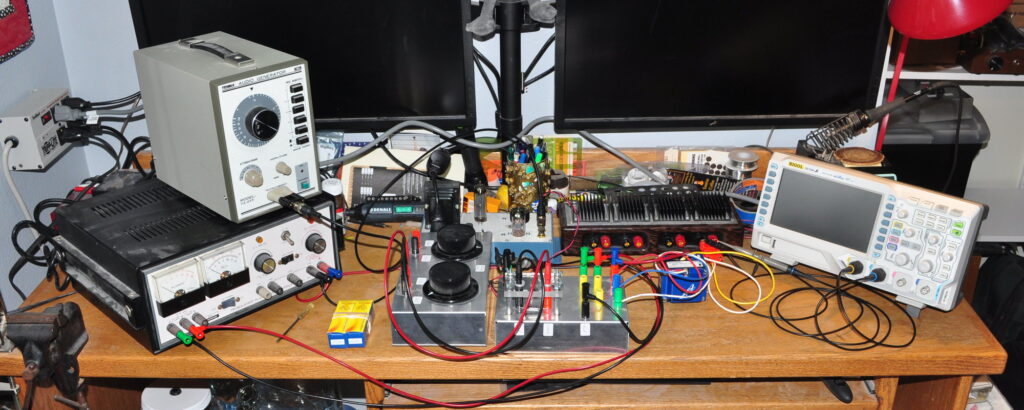We’ve had a bit of a cold and rainy snap here which has prevented me from getting to the chassis work for the new 807 amp. But that doesn’t mean I’ve been totally idle.
I decided that if I was going to be stuck in the house, I should make the most of all the free time. A while back I asked people which tube should be the next in the series of SE-UL bias optimization investigations (before I get to the EL34). The conclusion was that I should check out the EL84.
The 6BQ5/EL84 is a smaller power tube akin to the 6AQ5. However, a major difference is that the 6BQ5/EL84 is a true pentode and not a beam power tube. This will be the first true power pentode I’ve thoroughly investigated so the results should be interesting. The EL84 is a lower power tube with a maximum plate dissipation of 12W. In SE-UL this means that maximum power out will likely only be a handful watts. The 6AQ5 (i.e. 6V6 limited to 12W Pd) peaked out at a little over 4W in the 6V6 SE-UL Bias Investigation. I am hoping for similar performance out of the EL84.
The test equipment has been deployed to my desk and I’ve calibrated the driver to start gathering data. Here is the test setup.
I’ve still got a lot of work to do but I should have some results to report in a week or two.
As always, questions and comments are welcome.


It is nice that the EL84 is a popular tube and can easily be found at a lower price.
Quick Question – Without the voltage from UL tap going into the tube, can you put more voltage through the plate in a strapped triode?
In general, no. The real limiting condition is maximum power dissipation on the plate and screen. However, in small tubes (like the 6BQ5/EL34) there is generally a maximum screen to cathode voltage due to the close element spacing. In this tube, the limit is 300v for both plate and screen regardless of topology. In larger pentodes like the 6CA7/EL34 there are different voltage ratings for the screen and plate however, the lower screen limit sets the upper bound in triode mode operation.
That makes sense – I was just curious. Looking forward to the optimization results. Appreciate the quick reply!
According to several data sheets, a 6BQ5/EL84 should be able to do about 5 watts or so at about 10% THD. I’ve seen it reported that you can get about 3 watts of “clean” power to a speaker. Plenty for your living room.
It will be interesting to see how it goes. The theoretical maximum in SE mode is 50% efficiency ( η = Po/Pi ).
For the EL84 the maximum plate dissipation is 12W, so the maximum possible power out is 6W. But because of the shape of the plate transfer characteristics (especially in something other than pure pentode mode) and the loss in the output transformer, the realized efficiency will be lower. I actually did better than 35% in the 6V6 optimization study which is a good efficiency including transformer and load. Since I haven’t constructed any UL curves, the efficiency will have to just fall out of the test data.
The amp I am thinking of is the Mullard 3-3. Puts out 3 watts at 1% THD, with a frequency response from about 30 Hz up to over 20 kHz. But it may not be to your liking – pentode input stage (operating in a strange and novel to me way), EL84 running as a pentode output stage. And by Mullard’s own admission lots of global NFB to keep things under control.
Looking at the schematic, it’s just not my kind of amplifier. It involves all the things I try to avoid; pentode mode operation, direct coupled, global feedback (and ultra-sonic cutoff to control stability), sub-optimized output transformer, and simple RC filtering on the B+ supply. It looks like it was designed to a price point.